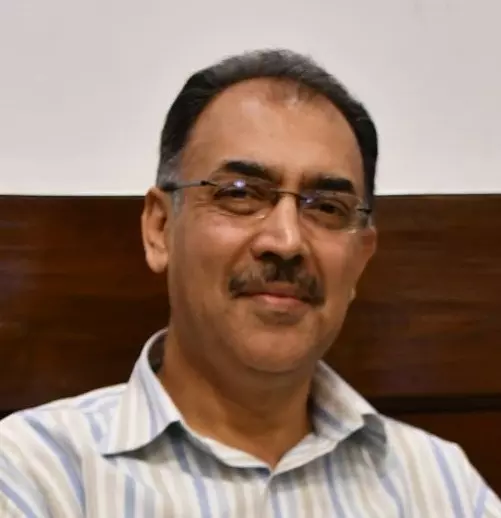Unlocking vast potential
The efforts aimed at boosting the generation of alternative livelihoods through seaweed farming need to be complemented with robust institutional credit and extensive risk coverage for optimal outcomes

Jeya Lakshmi, Jeya Thangam and Kaleeswari are natives of Mandapam village in District Ramanathapuram, Tamil Nadu. These women belong to poor coastal fisher families without any additional source of income. To enhance their income, they teamed to learn the basics of seaweed farming. Amidst the challenges of rough seas, seedling supplies and marketing, training has enabled them to produce seaweed, increase their income and, in fact, generate employment for six persons!
The above-mentioned success story and many more across the country are a part of a robust ecosystem for alternative livelihoods in fisheries and aquaculture, nurtured through the Pradhan Mantri Matsya Sampada Yojana (PMMSY). The latter, with the cooperation of state governments, has plugged critical gaps in fisheries development for more than 2.8 crore fishers/fish farmers, of which 44 per cent are women.
In India, seaweed grows abundantly along the coasts of Tamil Nadu, Gujarat, Lakshadweep, and Andaman & Nicobar Islands. Commercial farming practiced in the states of Tamil Nadu and Gujarat relies on a workforce that primarily consists of women workers. This is being supplemented with research and demonstrations along a coastline of over 8,000 kilometres (harbouring about 844 species) to explore the scope of approximately 9 million tonnes of production.
The primary mode of farming is vegetative propagation, using fragments from mother plants by growing them on floating bamboo rafts, monolines and tube nets over a crop duration of 45-60 days. Such farming can prove to be a boon by serving as an additional source of employment for coastal fishers during the fish breeding season (that entails a ban). A recent Niti Aayog study highlights that under optimal conditions, the net income from one hectare (400 rafts) of dry seaweed can reach up to Rs 13,28,000 per annum.
In fact, seaweed farming’s potential is multifaceted and revolutionary! First and foremost, it is a carbon sequester and, therefore, an effective instrument in the nation’s effort to achieve net-zero carbon emissions by 2070. Its application as a bio-stimulant is critical for regenerative agriculture, including livestock. Its areas of application range from pharmaceuticals and cosmetics to mining industries and as an additive. Additionally, some species of seaweed are becoming more and more important as nutritious food for human consumption. In France, seaweed is used in agriculture to increase yield and make crops more resilient, while in the United Kingdom (UK), it is used to develop biodegradable health sensors and fitness monitoring technologies.
Experts in India have raised several macro and micro issues that need to be addressed to strengthen the seaweed value chain. At the macro level, they acknowledge the tremendous progress made on suitable site selections by government-run R&D institutions along India's long coastline to gauge the factors of salinity, sea surface temperature and minimum water depth. They, however, highlight the impact of seaweed farming, for instance, on coral reefs, in ecologically sensitive areas. A related issue is the impact of exotic versus indigenous species of seaweed on biodiversity. At the micro level, they highlight the importance of water leasing, setting up seed banks and making available quality planting material through tissue culture. They have also stressed on the need for facilitating value addition and marketing in proximity to the farming communities.
Adopting ‘a whole of the government approach’, several steps are being initiated by the Government of India to address these critical issues. Recently, a ‘Multi-purpose Seaweed Aquapark’, with an investment of over Rs 125 crore, was approved to promote seaweed farming in six coastal districts of Tamil Nadu. Following a hub and spoke model, the Park intends to create hubs for seaweed seed production with drying & storage facilities and modern tissue culture labs. It also aims value addition through secondary processing, packaging etc. Herein, public-private partnerships will be encouraged. The Park will also address the critical needs for product standards and traceability. At the last mile, the involvement of women under the aegis of fish farmer producer organisations, self-help groups, joint liability groups and cooperatives has been envisaged.
The establishment of such cluster-oriented Parks is being complemented by designating key resource ICAR R&D institutions as Centres of Excellence (CoE) to handhold them for capacity-building, skilling and technology updation. A key plug in such CoEs is to support innovations by emerging fishery start-ups. ‘Zaara Biotech’, ‘Puakai Agriaqua’ and ‘Rafteck Solutions’ are examples of start-ups that have been incubated and are involved in seaweed and algal-based products processing. In fact, access is also being provided to these entities to connect to e-platforms such as Open Network for Digital Commerce (ONDC).
To further boost the generation of alternative livelihoods through seaweed farming, especially for women, the above efforts will have to be backed by improved access to institutional credit and incentives for comprehensive risk coverage through insurance.
The writer is Secretary, Department of Fisheries, Ministry of Fisheries, Animal Husbandry & Dairying, Government of India. Views expressed are personal



